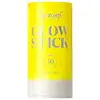What's inside
What's inside
 Key Ingredients
Key Ingredients

 Benefits
Benefits

 Concerns
Concerns

 Ingredients Side-by-side
Ingredients Side-by-side

Butyl Methoxydibenzoylmethane 3%
UV AbsorberEthylhexyl Salicylate 5%
UV AbsorberOctocrylene 10%
UV AbsorberC12-15 Alkyl Benzoate
AntimicrobialCalendula Officinalis Extract
Skin ConditioningCalophyllum Inophyllum Seed Oil
AntimicrobialCaprylic/Capric Triglyceride
MaskingDibutyl Ethylhexanoyl Glutamide
Skin ConditioningDibutyl Lauroyl Glutamide
Skin ConditioningDicaprylyl Carbonate
EmollientDiethylhexyl Syringylidenemalonate
Skin ProtectingHelianthus Annuus Seed Oil
EmollientIsododecane
EmollientIsohexadecane
EmollientLimnanthes Alba Seed Oil
Skin ConditioningMauritia Flexuosa Fruit Oil
Skin ConditioningOctyldodecanol
EmollientPentaclethra Macroloba Seed Oil
EmollientPolyester-8
Skin ConditioningTocopherol
AntioxidantButyl Methoxydibenzoylmethane 3%, Ethylhexyl Salicylate 5%, Octocrylene 10%, C12-15 Alkyl Benzoate, Calendula Officinalis Extract, Calophyllum Inophyllum Seed Oil, Caprylic/Capric Triglyceride, Dibutyl Ethylhexanoyl Glutamide, Dibutyl Lauroyl Glutamide, Dicaprylyl Carbonate, Diethylhexyl Syringylidenemalonate, Helianthus Annuus Seed Oil, Isododecane, Isohexadecane, Limnanthes Alba Seed Oil, Mauritia Flexuosa Fruit Oil, Octyldodecanol, Pentaclethra Macroloba Seed Oil, Polyester-8, Tocopherol
Polyamide-8
EmollientC12-15 Alkyl Benzoate
AntimicrobialCoco-Caprylate/Caprate
EmollientIsopropyl Isostearate
EmollientButyloctyl Salicylate
Skin ConditioningPolyamide-3
Vp/Eicosene Copolymer
Tetrahexyldecyl Ascorbate
AntioxidantTocopheryl Acetate
AntioxidantTocopherol
AntioxidantHylocereus Undatus Fruit Extract
Skin ConditioningRubus Chamaemorus Seed Oil
Skin ConditioningGlycine Soja Oil
EmollientCaprylyl Glycol
EmollientDiethylhexyl Syringylidenemalonate
Skin ProtectingPolyglyceryl-3 Diisostearate
EmulsifyingOryza Sativa Germ Extract
EmollientOryza Sativa
Octocrylene 3%
UV AbsorberPolyamide-8, C12-15 Alkyl Benzoate, Coco-Caprylate/Caprate, Isopropyl Isostearate, Butyloctyl Salicylate, Polyamide-3, Vp/Eicosene Copolymer, Tetrahexyldecyl Ascorbate, Tocopheryl Acetate, Tocopherol, Hylocereus Undatus Fruit Extract, Rubus Chamaemorus Seed Oil, Glycine Soja Oil, Caprylyl Glycol, Diethylhexyl Syringylidenemalonate, Polyglyceryl-3 Diisostearate, Oryza Sativa Germ Extract, Oryza Sativa, Octocrylene 3%
 Reviews
Reviews

Ingredients Explained
These ingredients are found in both products.
Ingredients higher up in an ingredient list are typically present in a larger amount.
C12-15 Alkyl Benzoate is made up of Benzoic Acid and long chain alcohols. It has a low molecular weight.
C12-15 Alkyl Benzoate is an emollient and texture enhancer. Due to its solubility, it is often used in sunscreens to help evenly distribute active ingredients.
As an emollient, C12-15 Alkyl Benzoate helps soften and hydrate your skin. Emollients create a film on your skin that traps moisture within.
This ingredient has been reported to cause eye irritation.
Learn more about C12-15 Alkyl BenzoateDiethylhexyl Syringylidenemalonate (DESM) is a photostabilizer, antioxidant, and SPF booster.
One of DESM's main roles is stabilizing UV filters, especially avobenzone. Avobenzone is notoriously unstable when exposed to sunlight. By enhancing the stability of these filters, DESM helps maintain the sunscreen's effectivess through wear. It also helps improve protection against long-wave UVA rays by increasing the wavelength of the formula.
Besides enhancing UVA protection, DESM can boost the SPF of high-SPF formulations by up to 5 units.
DESM also preserves the color integrity of cosmetic products and helps reduce the chance of yellowing of fading due to light exposure.
This ingredient is typically found in concentrations between 0.3% - 0.5%. There are currently no maximum usage limits by regulatory bodies.
Though this ingredient is a chemical UV filter, it can often be found in "100% mineral" sunscreens. This is due to regulatory loopholes.
Learn more about Diethylhexyl SyringylidenemalonateOctocrylene protects skin from sun damage. It absorbs UV-B with peak absorption of 304 nm. It is a common sunscreen ingredient and often paired with avobenzone, a UVA filter. This is because octocrylene stabilizes other sunscreen ingredients by protecting them from degradation when exposed to sunlight. Octocrylene is a photostable ingredient and loses about 10% of SPF in 95 minutes.
Octocrylene also acts as an emollient, meaning it helps skin retain moisture and softens skin. It is oil-soluble and hydrophobic, enhancing water-resistant properties in a product.
Those who are using ketoprofen, a topical anti-inflammatory drug, may experience an allergic reaction when using octocrylene. It is best to speak with a healthcare professional about using sunscreens with octocrylene.
The EU allows a maximum of these concentrations:
Learn more about OctocryleneTocopherol (also known as Vitamin E) is a common antioxidant used to help protect the skin from free-radicals and strengthen the skin barrier. It's also fat soluble - this means our skin is great at absorbing it.
Vitamin E also helps keep your natural skin lipids healthy. Your lipid skin barrier naturally consists of lipids, ceramides, and fatty acids. Vitamin E offers extra protection for your skin’s lipid barrier, keeping your skin healthy and nourished.
Another benefit is a bit of UV protection. Vitamin E helps reduce the damage caused by UVB rays. (It should not replace your sunscreen). Combining it with Vitamin C can decrease sunburned cells and hyperpigmentation after UV exposure.
You might have noticed Vitamin E + C often paired together. This is because it is great at stabilizing Vitamin C. Using the two together helps increase the effectiveness of both ingredients.
There are often claims that Vitamin E can reduce/prevent scarring, but these claims haven't been confirmed by scientific research.
Learn more about Tocopherol